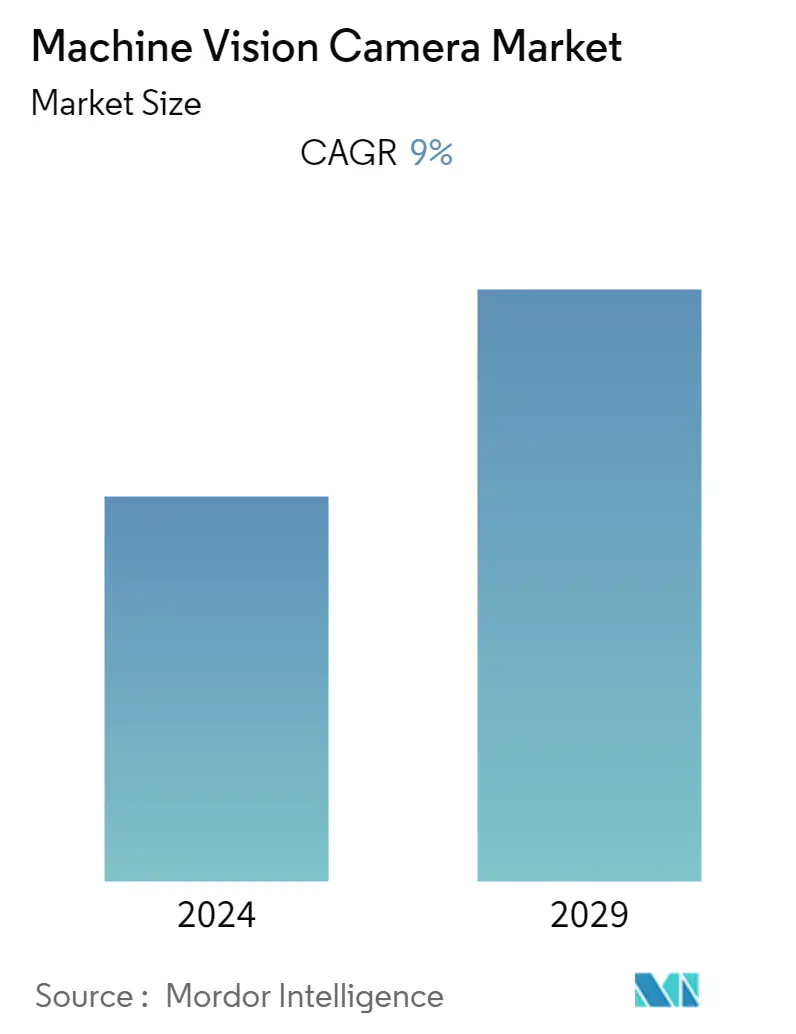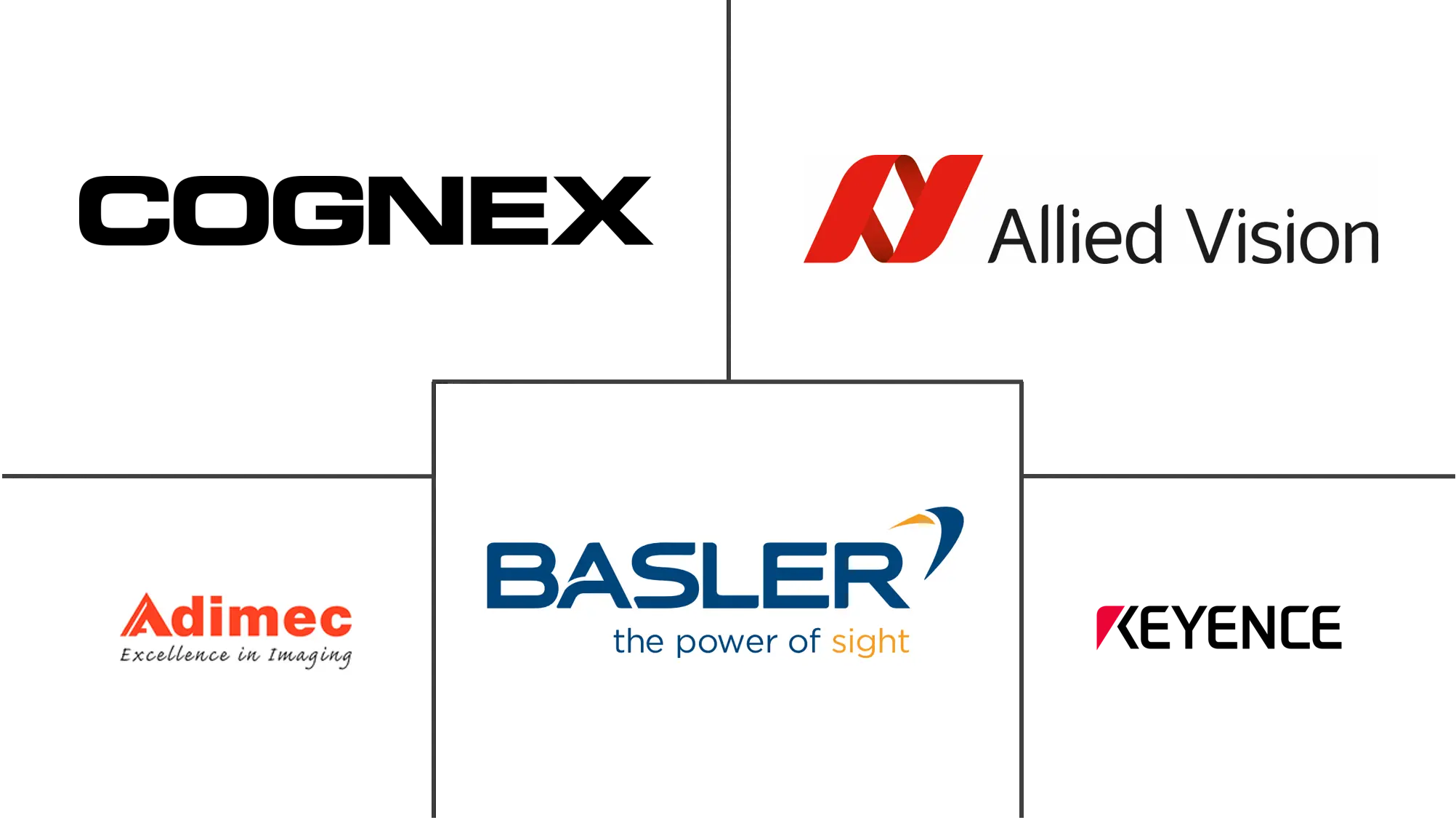Market Size of Machine Vision Camera Industry

| Study Period | 2019 - 2029 |
| Base Year For Estimation | 2023 |
| CAGR | 9.00 % |
| Fastest Growing Market | Asia Pacific |
| Largest Market | North America |
| Market Concentration | High |
Major Players
*Disclaimer: Major Players sorted in no particular order |
Machine Vision Camera Market Analysis
The Machine Vision Camera Market is expected to register a CAGR of approximately 9% over the forecast period (2021 - 2026). The machine vision technology uses an image-recognition algorithm to the object within the image. It facilitates a more detailed and accurate picture of the object without distortion for the applications such as automation, robotics, agriculture drones, and 3D modeling.
- The industries across the domains globally are moving towards automation by adopting advanced technologies for more efficient operations and processes. The manufacturing industries have been using cameras for decades for quality assurance, but with the advancements and AI, the applications range widened for inspection, measurement, and microscopy. The growing implementation of advanced technologies across industries are driving the market of machine vision camera.
- The adoption has gained traction in real-time traffic counting with machine vision, and image recognition enables the automation of control room work and preventive intervention in situations. The companies offering machine vision cameras are experiencing significant growth in recent years due to the increasing demand for such products.
- For instance, Cognex's revenue, has reached USD 806 million and it grew with a CAGR of 21% in the last five years. Also, companies are highly investing in developing their products. In 2018, Cognex spent 14% of its revenue on research and development.
- However, the lack of skilled labour and inconsistency in demand and requirements from the industries limit the growth of the market to an extent.
Machine Vision Camera Industry Segmentation
The scope of the study for the machine vision camera market is limited to both types, Inline, and area scan. The study has considered the offerings of the product as well as machine vision camera accessories by vendors and their applications in a wide range of industries globally.
| By Type | |
| Inline | |
| Area Scan |
| By End-user Industries | |
| Electronics & Semiconductor | |
| Automotive | |
| Heathcare | |
| Food Processing | |
| Aerospace | |
| Other End-user Industries |
| Geography | |
| North America | |
| Europe | |
| Asia-Pacific | |
| Rest of the World |
Machine Vision Camera Market Size Summary
The machine vision camera market is experiencing significant growth, driven by the increasing adoption of automation and advanced technologies across various industries. This technology, which utilizes image-recognition algorithms for detailed and accurate object representation, is becoming integral in sectors such as manufacturing, robotics, agriculture, and 3D modeling. The manufacturing industry, in particular, has expanded its use of machine vision cameras beyond quality assurance to include inspection, measurement, and microscopy, fueled by advancements in artificial intelligence. The automotive sector is also a major contributor to market expansion, with the rise of autonomous vehicles and advanced driver-assistance systems (ADAS) driving demand for machine vision cameras in both vehicle production and operation. Despite challenges like a shortage of skilled labor and fluctuating industry demands, the market continues to grow as companies invest heavily in research and development to enhance their product offerings.
Regionally, the demand for machine vision cameras is poised for steady growth, particularly in Asia, where significant investments in end-user industries and connected infrastructure projects are underway. The automotive sector in this region is seeing increased investments, especially in electric vehicles, which further propels market growth. International electronics and automation companies are also investing in Asian machine vision firms, recognizing the region's potential. The market is moderately consolidated, with key players like FLIR Systems, Inc., and Cognex Corporation leading through strategic partnerships and innovative product developments. These companies are expanding their product portfolios to include advanced machine vision camera accessories, catering to diverse industry needs.
Machine Vision Camera Market Size - Table of Contents
-
1. MARKET DYNAMICS
-
1.1 Market Overview
-
1.2 Market Drivers
-
1.2.1 Increasing Implementation of Advanced Technologies in Industries
-
-
1.3 Market Restraints
-
1.3.1 Lack of Skilled Labour and Inconsistency in the End-user Requirements/Demands
-
-
1.4 Industry Attractiveness - Porter's Five Force Analysis
-
1.4.1 Threat of New Entrants
-
1.4.2 Bargaining Power of Buyers
-
1.4.3 Bargaining Power of Suppliers
-
1.4.4 Threat of Substitute Products
-
1.4.5 Intensity of Competitive Rivalry
-
-
1.5 Technology Snapshot
-
1.5.1 Key Interface Methods For Machine Vision Cameras
-
1.5.1.1 USB 2.0/USD 3.0
-
1.5.1.2 GigE
-
1.5.1.3 Camera Link
-
1.5.1.4 Others
-
-
1.5.2 Key Technological Advancements - Shutter Technology, Hyperspectral Imaging, etc.
-
-
-
2. MARKET SEGMENTATION
-
2.1 By Type
-
2.1.1 Inline
-
2.1.2 Area Scan
-
-
2.2 By End-user Industries
-
2.2.1 Electronics & Semiconductor
-
2.2.2 Automotive
-
2.2.3 Heathcare
-
2.2.4 Food Processing
-
2.2.5 Aerospace
-
2.2.6 Other End-user Industries
-
-
2.3 Geography
-
2.3.1 North America
-
2.3.2 Europe
-
2.3.3 Asia-Pacific
-
2.3.4 Rest of the World
-
-
Machine Vision Camera Market Size FAQs
What is the current Machine Vision Camera Market size?
The Machine Vision Camera Market is projected to register a CAGR of 9% during the forecast period (2024-2029)
Who are the key players in Machine Vision Camera Market?
Keyence Corporation, Adimec Advanced Image Systems BV, Allied Vision Technologies GmbH, Basler AG and Cognex Corporation are the major companies operating in the Machine Vision Camera Market.

